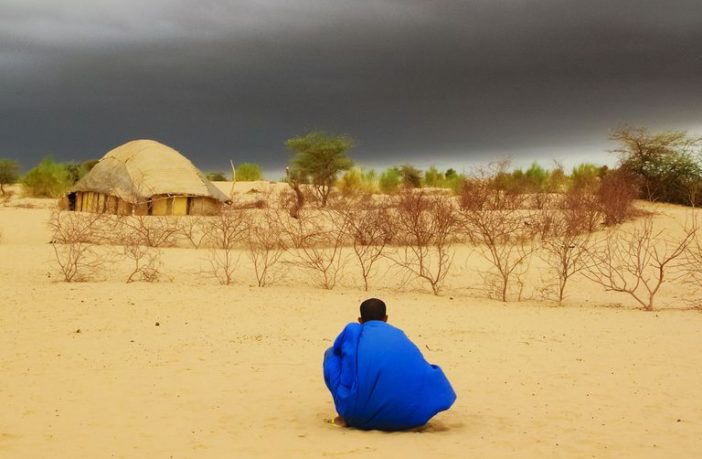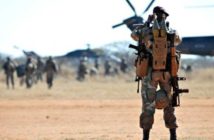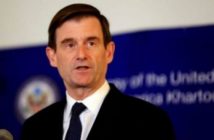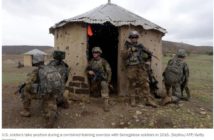Strategy Page
Mali continues to be the most dangerous UN peacekeeping operation with over 200 dead so far. This is largely due to northern Mali, where most of these deaths occur.
There was lots of violence up there since (and before) the peacekeepers arrived in early 2013. The peacekeepers are mainly African and in 2018 the combined forces suffered a death rate of about 130 per 100,000 per year (a standard measure of such things.) The rate in 2017 was nearly double that and that high rate seems to be returning in 2019. A lot of the violence has moved south to central Mali.
While being a peacekeeper remains a dangerous job it’s still less dangerous than places like Afghanistan, where in 2013 the rate (200 per 100,000) was lower for all foreign troops there. That was down from the peak 587 per 100,000 in 2010, which was about what it was during the peak years in Iraq (2004-7). The action in Mali is less intense than in pre-2014 Afghanistan or pre-2011 Iraq but is more than double the rate for peacekeepers worldwide. Total Mali peacekeeper casualties since mid-2013 are about 500 dead and wounded and losses but have been much heavier among the Islamic terrorists. The local pro-government militias also suffer heavier casualties as do the Mali security forces (army and police.)
The 12,500 peacekeepers come from 30 countries. Most come from a few African nations. The smaller number of Western troops bring with them specialized equipment and skills. France also has about 2,700 troops operating in Mali and another 1,800 in neighboring countries.
Then there are the Mali security forces. These consist of 7,000 military and nearly 10,000 police. About 6,000 of the police are local and have the least training and suffer the most from corruption. In addition, there are about 4,000 paramilitary police (Gendarmerie) which handle rural areas, mainly in the north. The Gendarmerie is also corrupt and that hampers its effectiveness in rural areas where traditional (mainly tribal or religious) leaders have more authority, and respect from the locals than the national or local government. In northern and central Mali the Islamic terrorists have managed to either intimidate or gain sympathy from most of the rural population by working through (and sometimes threatening) the local traditional leaders. To achieve this took several years of effort. Now foreign and Malian troops find that obtaining information from rural civilians is increasingly difficult. This was no accident. Local Islamic terrorists have learned to combine making themselves useful with threats. That means achieving credibility, usually via kidnapping, not killing, when they threaten severe punishment for those who inform on them. The rural population has a hard life and doesn’t want any more problems. The Islamic terrorists are active in smuggling, mainly drugs, and offer some jobs to cooperative tribes or communities. That’s more than the government offers out in the countryside. This is another example of how ineffective or counterproductive local government (both are common in Africa) are usually a major factor in how much Islamic terrorist activity there will be in nations with a Moslem majority or sizeable minority. In theory, the Gendarmerie should also be trying to work with local leaders. Instead, the Gendarmerie acts like a foreign occupation force, if only because most members of the Gendarmerie are from the more populous south and are usually black African while most of the (much smaller) northern population is Arab or Taureg (distant kin of the ancient Egyptians).
The army has about 7,000 troops and most have undergone training or retraining in training programs paid for and run by Western (mainly European) nations. As a result, the army is somewhat less corrupt and much more professional. Like the Gendarmerie, the army is also seen as a foreign occupation force up north and in some parts of central Mali.
Follow The Easy Money
The growth of Islamic terrorist activity in Mali is fueled by more cash available to sustain and expand it. This comes from smuggling. For more than a decade it has been drugs, mainly South American cocaine flown in and locally produced narcotics like hashish. Since 2011 people smuggling has become more common, and lucrative. For most African illegal migrants headed for Europe, the easiest, and safest, way to get there is to pay smugglers to get you to the Mediterranean coast where another group of smugglers, in partnership with European gangsters, will try to get you across the Mediterranean. This people smuggling is big business, especially the final phase across the sea. While drugs are more compact and lucrative to smuggle, moving people is also profitable, People smuggling also it enables the Islamic terrorist groups that dominate the sub-Saharan smuggling to hire more locals to help with the labor-intensive movement of people north. Hiring more locals cements relations with local communities and their leaders.
Action And Reaction
Since 2018 there has been a lot more Islamic terrorist violence in Mali. Before that more Islamic terrorist activity happened in neighboring Burkina Faso and Niger. That was why, in 2018, the G5 Sahel Joint Force was organized to deal with transnational Islamic terrorist organizations. G5 was a consortium of five Sahel (the semi-desert area stretching across Africa from Senegal to Somalia) nations; Mali, Mauritania, Burkina Faso, Niger and Chad. Each contributed troops best able to deal with Islamic terrorism and G5 operated throughout the Sahel region as needed. By 2019 G5 forces were spending more time in Mali, Niger and Burkina Faso,
Mali is still the most troublesome Sahel nation but also has the most outside assistance, including a peacekeeping force along with a separate French counter-terror force that also covers much of the Sahel along with the G5 force. The Mali contingent of the G5 is considered the least capable and that has to be taken into account while the training program for the Mali military slowly improves the quality of leadership and troop reliability. With Mali secured by all these foreign troops, the G5 has been able to deal with Islamic terror problems elsewhere, especially Burkina Faso and Niger.
The G5 force consists of 5,000 soldiers and police that are stationed in three operational areas along with troops familiar with local conditions. Thus Sahel East consists of troops from Chad and Niger. Sahel Central is staffed by troops from Niger, Mali and Burkina Faso while Sahel West uses troops from Mali and Mauritania. Some of the G5 force was operational by the end of 2017 and by early 2018 the G5 force had already taken part in several counter-terror operations, one of them in the area where the borders of Mali, Niger and Burkina Faso meet.
What G5 could not do was replace a lack of security forces in one of its member nations. Burkina Faso is the best example of this because, after a new government took power in 2014, the internal intelligence and security forces were reorganized and became much less effective. Islamic terrorists took note and established themselves in the part of Burkina Faso adjacent to Mali. As a result that part of Burkina Faso has seen an increasing amount of Islamic terrorist activity since 2015. In that time at least 300 Burkina Faso civilians and security forces personnel have died, as well as an even larger number of Islamic terrorists. This is over 70 percent of such deaths suffered throughout the country during that period.
Since 2016 there has been more violence in northern Mali and that spread to central Mali and to the southeast along the Burkina Faso border. Most (42 percent) of the 137,000 Mali refugees are in Mauritania with 39 percent in Niger and 19 percent in Burkina Faso. Mauritania is the western neighbor of northern Mali while Niger east and Burkina Faso southeast. The other neighbors (Senegal, Guinea and Ivory Coast) only border the much more peaceful south.
While the 2013 French counterterrorism operation in the north initially drove thousands of Islamic terrorists into neighboring countries, many slowly returned. But many did not and that’s when the Islamic terror problem in Burkina Faso went from troublesome to terrible, aided by a new government that was less effective dealing with it. Burkina Faso still hosts over 30,000 refugees from Mali. These refugee camps often serve as a sanctuary for Mali Islamic terrorists, as long as they do not attract attention in the camp. That’s one reason many countries don’t like to host refugees from a nation that has a serious Islamic terrorist problem.
Burkina Faso is, like Mali, landlocked and has 17 million people (about 20 percent more than Mali). Burkina Faso also lacks a troublesome Tuareg/Arab minority in the north. Because Burkina Faso is south of Mali it also lacks the semi-desert terrain common in northern Mali. That is where the Malian Tuareg/Arab minority live. Burkina Faso also has more religious diversity with a quarter of the population being Christian and 60 percent Moslem. Moreover the Moslem population consists of several different “schools” of Islam, some of them quite hostile to Sunni Islamic terrorism as practiced by al Qaeda and ISIL. In contrast, Niger and Mauritania are almost all Moslem and have always been the home for some Islamic conservatives who were not satisfied unless their neighbors also adopted Islamic conservatism. Religious pluralism in Burkina Faso helps restrict the Islamic terrorist activity to one area, but that is adjacent to central Mali and provides a handy sanctuary for Mali Islamic terror groups.
Tribal Truce Trepidation
Despite the Islamic terrorism sanctuary adjacent to Central Mali, the Mali government has been able to negotiate a truce between the warring Fulani and Dogon militias in that area. Since July that peace deal has been holding. The tribal violence had escalated during the four months prior to the peace deal, left hundreds dead and caused hundreds of thousands to flee their homes. The fighting between Dogon and Fulani tribal militias had been going on for years but the 2019 surge began with a spectacular March massacre where Dogon militia attacked a Fulani village. That action left over 160 Fulani dead and it wasn’t just the Fulani who were outraged.
The Fulani were the ones who started this violence years ago as they sought to force farmers off the land and away from water supplies the Fulani coveted. But the Fulani raids were meant to terrorize, not exterminate. The Dogon tribe, one of the larger sedentary groups in central Mali, has always been the most organized and aggressive in confronting Fulani expansion into the better watered and more fertile (for grass and crops) Niger River Valley and beyond. After 2012 and the separatist/Islamic terrorist uprising in the north there was an increase in Fulani-farmer violence and the bloodiest incidents often involved Dogon militias fighting Fulani. Calls for the government to disarm the Dogon militias were popular for a while until police and army commanders convinced the government that attempting disarmament would be bloody and, in the long run futile. For the Dogon and Fulani, all this feuding is a matter of life or death while the politicians are concerned about appeasing popular outrage, which tends to fade quickly. Then there are the critical foreign media, which influence foreign aid decisions and are more important, especially for corrupt politicians who steal much of that aid. Getting the Fulani and Dogon (and other farming tribes) to settle the land and water disputes peacefully is more difficult but offers the only lasting solution and the more difficult one. Those fundamental conflicts are still there, which is why the current peace deal will be under growing pressure and will eventually collapse into renewed violence.
The Dogon/Fulani feuding in central Mali has been the main cause of over 200,000 civilians being forced from their homes during the first six months of 2019. That is more than five times as many refugees created in the first six months of 2018. Most of the 700 terrorism and outlaw related deaths so far in 2019 have occurred in central Mali. There is still violence in the north but the Islamic terror groups, even ISGS (Islamic State in Greater Sahara), the local ISIL (Islamic State in Iraq and the Levant) franchise, have been avoiding combat and concentrating on staying alive and taking care of business (smuggling).
The Dogon-Fulani “ceasefire” continues to be at the mercy of natural (drought, hunger) and political (corrupt politicians) events. In the north, the basic problem is poverty and the negative impact banditry and Islamic terrorism is having on efforts to revive the economy. A lot of the “Islamic terrorist” violence up there is just bandits. It gets more attention if the victims describe the attackers as Islamic terrorists.
Fulani Follies
Fulani are also the biggest supporters of the JNIM (Jamâ’ah Nusrah al Islâm wal Muslimîn, or Group for the support of Islam and Moslems) al Qaeda coalition. This organization was formed in early 2017 to consolidate the many separate Islamic terror groups in Mali. In part, this was a reaction to the growing threat from ISIL, which is hostile to everyone who is not ISIL and will attack or recruit from the JNIM members like AQIM (Al Qaeda in the Islamic Maghreb), Ansar Dine, FLM and several other smaller groups. Another reason for the merger was to make it easier to pool resources, especially information and practical advice, and coordinate with other Islamic terror groups in the region. This reduces friction and destructive feuding. Making a coalition like this work is always difficult, especially considering the importance of ethnic differences. The FLM is Fulani (the largest local tribal contribution) while the other groups are largely Tuareg, Arab with some having a lot of foreigners. Note that JNIM did not absorb all of AQIM groups in the area, just local groups that had long been identified with al Qaeda. The income from the drug trade keeps a lot of these factions in business. Islamic terrorists know that business and religious fanaticism do not mix and keep it that way. Those groups that did not went broke and withered to nothing.
Many other Fulani are members of an ISIL faction that operates on both sides of the Niger border in the north. This group calls itself ISGS (Islamic State in the Greater Sahara) and is largely local Tuaregs plus foreigners. Al Qaeda considers itself “defenders of Islam” and sees ISIL as the true Islamic terrorists who attack anyone who disagrees with them.
October 7, 2019: There were two attacks on peacekeepers which left one dead and four wounded. In the north (outside Kidal) a UN vehicle hit a landmine, which killed one peacekeeper and wounded three. In central Mali (Bandiagara) one peacekeeper was wounded when Islamic terrorists fired on a peacekeeper base.
October 1, 2019: In central Mali, near the Burkina Faso border, JNIM gunmen attacked two army camps (Boulkessi and Mondoro). This left about 40 soldiers dead and even more wounded. Both camps were briefly occupied by the Islamic terrorists who took as many weapons (76 assault rifles and machine-guns well as a few mortars) and whatever else could be carried by about twenty stolen army vehicles. The Islamic terrorists also claimed several soldiers, including a colonel, were taken prisoner. Reinforcements quickly arrived, including French warplanes. The Mali Army denied anyone was captured and claimed 15 attackers were killed and many more wounded. Similar attacks have long taken places across the border in Burkina Faso but now such violence is common on the Mali side of the border.
September 26, 2019: In central Mali (Mopti region), a supply (food and fertilizer) convoy was ambushed by Islamic terrorists. A roadside bomb and gunfire left seven soldiers dead and seven wounded. Reinforcements were sent to pursue the attackers.
September 19, 2019: In central Mali (Ségou region) a corrupt police chief died when an angry mob of locals set fire to the police station he was in. The police commander had a reputation for corruption before he was assigned to this area. Locals accused him of working with local gangsters and thefts increased after the dead commander took control of the area. The police under his command did not like him either. Corruption in the national police force is rampant and the government will often transfer an obviously corrupt commander rather than prosecute or fire him. In the Ségou incident, the commander had served before in the town where he was killed and was transferred to another town rather than be investigated and prosecuted. Why the government moved him back to where he was known to be corrupt is unclear. One civilian died in the riot that led to the police commander’s death.







